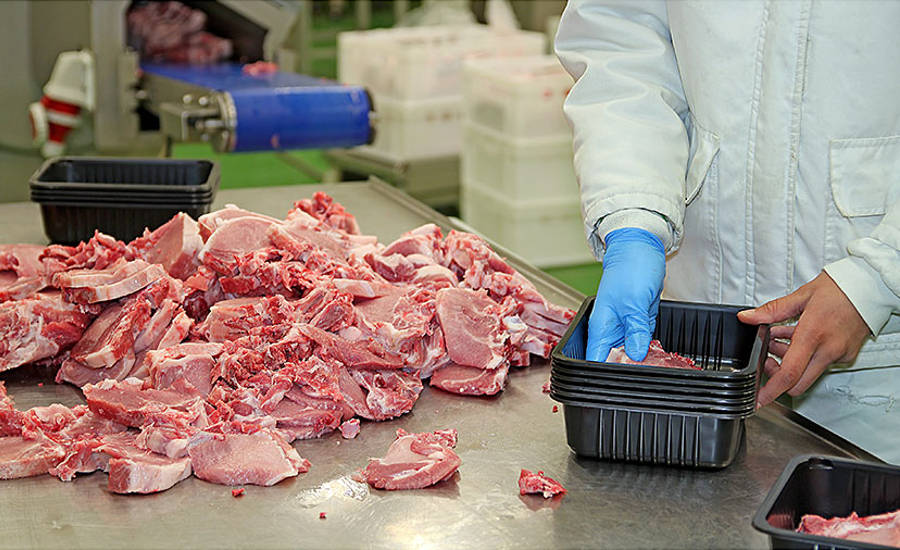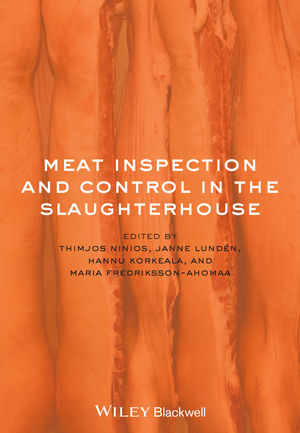Is grass-fed beef safer than conventional beef? As that debate rages on in the consumer world, researchers are testing the effects of a grass-fed diet versus grain-fed in cattle’s stomach.
Workers hold the key to meat and poultry safety.
The inability of plant employees to follow such hygienic practices as proper hand washing and wearing sanitized personal protective equipment can lead to contamination, the spread of foodborne illness, reduction in product shelf life and product recalls.
While operators can reduce incidents through ongoing worker training and monitoring employees, meat and poultry processing facilities will never be free of food safety threats, analysts say.
“Employee behavior defines our food safety culture,” says John Butts, advisor to the chief executive officer at Land O’Frost, a Lansing, Ill.-based lunch meat supplier, and president of St. John, Ind.-based consulting firm Food Safety By Design. “But worker actions are based upon what management and employee peer pressure will allow. Do not always blame the employee for mishaps, as they often are not the root cause of contamination.”
It is important for meat and poultry plants to have stringent worker hygiene guidelines in order to reduce the prospect of personnel contaminating machinery, surfaces and, subsequently, proteins, he says.
“It is common to transfer contaminates from one hygienic zone to another,” Butts says. “This may result from employees carrying pathogens on their hands or feet or touching bacteria on equipment.”
Extensive ongoing instruction on hygienic procedures is essential for minimizing such incidents, and leveraging a variety of teaching tools can keep training interesting, analysts say. Alternatives include videos, workbooks and hands-on demonstrations, while signs also can remind workers to wash their hands frequently and use hair nets.
Make hand-washing a habit
“Employees get busy and don’t remember to wash their hands enough,” says Terry Houser, extension meat specialist and associate professor of meat science in the Department of Animal Sciences and Industry at Kansas State University, in Manhattan. “It is important to train workers to wash when they enter a facility or a new room, or after they touch contaminants, such as a product that hits the floor, dirty equipment or a door knob. We weren’t born knowing that you have to wash your hands all the time.”
Teaching the proper hand washing methods, meanwhile, is crucial for maintaining cleanliness, he says.
“Some people barely get their hands wet and may not even use soap,” Houser says. “We can watch videos, but hands-on instruction is always more effective.”
Situating sinks in key plant locations also will remind workers of the importance of hand washing while making it easier for employees to frequently scrub, says Jeff Sindelar, extension meat specialist and associate professor in the Department of Animal Sciences at the University of Wisconsin in Madison.
Along with recurring hand washing, hygienic mandates can spell out bathing requirements; the need to cover cuts and wounds; and the necessity of routinely changing into sanitized garments, including new aprons and gloves, he says.
While personal protective equipment and other outerwear provide an additional level of hygienic protection, wearing such items can create a false sense of security if workers are not vigilant in protecting the garments from contamination, Sindelar notes.
“Latex gloves do a great job of creating a physical barrier from the meat and poultry when employees do not wash their hands enough,” he says. “But workers are defeating the entire purpose if they touch areas that will contaminate the gloves, such as non-food contact surfaces.”
Protect the product
Clean garments are an important barrier that separates microorganisms on workers from meat and poultry but should not act as another form of hazard, says Jonathan Campbell, meat extension specialist and assistant processor of animal science, in the Department of Animal Science at Pennsylvania State University, in University Park.
“It is important, especially in ready-to-eat areas, that outer garments do not come in contact with sources of contamination,” he says, noting workers should help prevent the spread of pathogens by changing into clean attire at the start of a shift and after meal and restroom breaks.
To ensure employees consistently follow hygienic procedures, co-workers and supervisors should routinely monitor employee actions and call out improper behavior as incidents occur, says Blaine Brown, manager of the West Lafayette, Ind.-based Boilermaker Butcher Block, a state-inspected meat plant and retail outlet operated by Purdue University’s Department of Animal Science in the College of Agriculture. The plant produces beef, pork and poultry products.
Such surveillance is necessary to combat worker complacency and spotlight those who might need retraining because of continual gaffs, he says.
“Mistakes get made regardless of how much signage on hygienic behavior is present,” Brown says, “so operators should take immediate corrective action when they notice mishaps on plant floors.”
Frequent training also is essential for keeping hygiene top of mind, Kansas State’s Houser says, adding that “we need to tell people things several times before they remember them. That is just human nature. You can’t over-communicate.”
Kansas State operates a U.S. Department of Agriculture-inspected meat lab that produces fully cooked and portion-controlled proteins such as steaks, roasts, hamburgers, pork stir fry and beef stir fry that it sells to both the public and the university’s housing and dining facilities. The lab has about 20 student employees and a full-time manger.
“Everyone has to be vigilant in maintaining good hygiene,” Houser says. “It is not going to happen by just telling employees about requirements a single time.”
In addition, it is important for workers to understand the reasons for frequent hand washing and not wearing dirty clothes and shoes, says Lyda Garcia, meat extension specialist and assistant professor of meat science in the Department of Animal Sciences at Ohio State University, in Columbus.
“It can lead to negative consequence if workers don’t comprehend the importance of hygienic measures and we will struggle as an industry,” she says.
Butts agrees, noting: “All employees must understand why we ask them to do things in a certain way. Often our procedures are not the simplest and easiest to perform. Attitudes and procedures must be aligned in a food safe manner.”
Create an unpleasant picture
Plant operators, meanwhile, can powerfully illustrate the ramifications of hygienic negligence by showing workers pictures of people suffering from foodborne illnesses, Garcia says.
“A one-hour training session isn’t always effective,” she says. “Sometimes demonstrating consequences and saying ‘this could be your child’ is more effective than a simple presentation.”
One-on-one training also is often more instructive than having employees watch videos, Garcia says.
“A video is cold and generic, but giving someone your time is like giving them a million dollars,” she says. Workers, Garcia adds, will pay more attention to personalized instruction and feel less intimidated if they can identify with their instructor’s education level or native language.
Houser says such guidance should include making workers aware of the need to keep all personal protective equipment sanitized, including hard hats and no-cut gloves.
“Gloves aren’t there to just keep the hands shielded but to keep the products safe,” he states. “You have to press on employees that the spread of foodborne illness can be a life or death situation.”
In addition, all employees that are near cooked products should wear clean head coverings and frocks along with disposable gloves, Brown says.
Other hygienic fundamentals include not wearing jewelry on the job, having plants provide cleaning and disinfection stations for clothing and equipment and ensuring all workers remove their equipment before using rest rooms, Garcia says.
Plant operators, meanwhile, should develop training procedures after auditing workers’ performances, she says, adding that specific instructions will differ by circumstances.
“Employees vary by knowledge, skill and how long they have been working at a plant,” Garcia says. “So operators can’t expect to have the same amount and types of training for everyone.”
Yet, despite the level and frequency of training, there will always be hygienic mishaps, she says.
“Because you are dealing with humans, there are bound to be mistakes,” Garcia says. “That is why supervisors should always be vigilant in monitoring the hourly employees, whether in their work lines or elsewhere in the plant.” NP







Report Abusive Comment